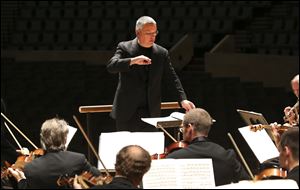
REVIEW
Mahler, Wagner romance the symphony audience
Toledo Symphony Classics Concert hits right notes
3/18/2017“There is just no music on Earth that can compare to ours. The angelic voices gladden our senses, so that all awaken for joy.”

Stefan Sanderling conducts the Toledo Symphony Orchestra.
This fitting quote is cited from Mahler’s Symphony No. 4, the work that formed the second half of Friday evening’s Toledo Symphony Classics Concert. Also on the program were Wagner’s Prelude to Tristan and Isolde and Schoenberg’s Variations for Orchestra, op. 31.
The concert read like a beginner’s field guide to romantic expressionism. On the podium was principal conductor Stefan Sanderling. As always, when he is there, the symphony excels every artistic expectation.
Wagner opened and was followed by the Schoenberg performed with no break. According to the program notes, this was so that “a more concrete connection between the pieces could be drawn.” Indeed the two are bookends.
This specific Wagner opened the door to the world of tonal ambiguity, pushing aside the harmonic underpinnings that had prevailed for 200 years of music history, leaving the listener tonally drifting.
Sanderling met this challenge with clear and concise direction, carefully shaping the slithering chordal structures and soaring melodic lines with intent and purpose, holding the audience afloat in a sea of romantic angst and longing.
At the other end of this harmonic morass stands the Schoenberg: the work that solidified his compositional philosophy of dodecaphony, or 12-tone composition. No note is given tonal preference over another. Atmospheric sound color — klangfarben — prevails over melodic and harmonic constructs.
Again, Sanderling expertly defined the intellectual work. He moved beyond academic rigor, bringing musical intent to the forefront, creating a masterful interpretation of the work’s expressionism. For the audience, perhaps this was not as aesthetically accessible as the Wagner, but it was the ultimate outplay of tonal degradation and disintegration.
Last came Mahler, the middle ground in the evening’s romantic foray. The work portrays a child’s vision of heaven, replete with sleigh bells, joyous melodies, and satisfying, secure tonality.
The pinnacle of the piece was soprano Rachele Gilmore, commanding the final movement’s demanding lyric solo. Using a coloratura versus a dramatic soprano was an interesting choice, but Gilmore rose to the challenge with a grace and beauty of line that was nothing less than celestial.
The program will be repeated 8 p.m. Saturday in the Toledo Museum of Art Peristyle, 2445
Monroe St., Toledo. Tickets and more information 419-246-8000 or toledosymphony.com.
Contact Wayne F. Anthony at classics@theblade.com.